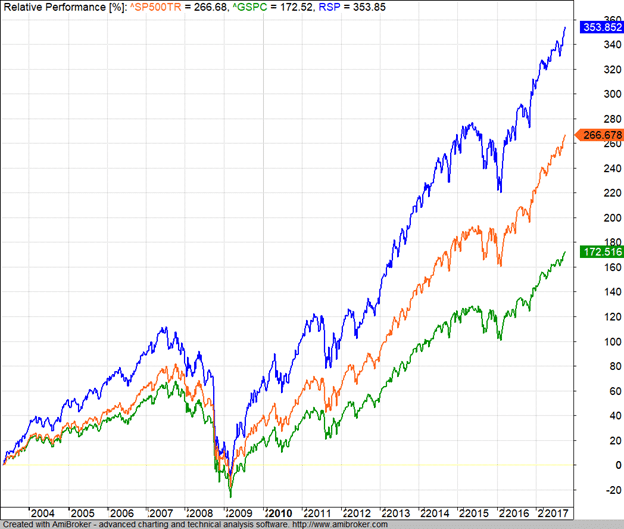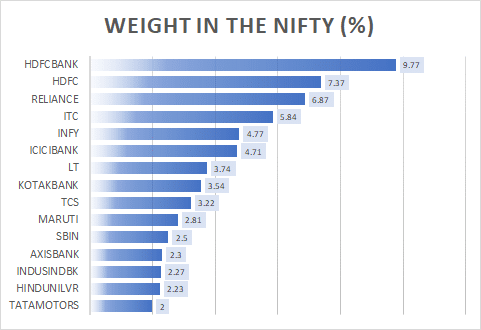
Note: This is a post sponsored by DSP Blackrock Mutual Fund. Please do not treat this article as a recommendation; we aim to provide information and education about the concept of Stock Market Indexes and specifically, of an equal weighted one.
In our previous post, we looked at returns of the Equal Weighted Index versus Market Cap Weighted Index. Today we shall look at Risk. Do note that while the data starts from 1995, the Index has actually become available only in 2017. We shall also try and see the performance of similar Index funds elsewhere.
Since the Index comprises the same set of stocks that are part of Nifty 50, there isn’t too much of a difference between risk profiles of Equal Weighted versus the Market Cap Weighted Index.
The correlation of weekly returns is nearly 96%.
A significant change between Market Cap Weighted Nifty 50 and Equal Weight Nifty 50 is the total free float market capitalization. HDFC Bank for instance is the top weight among Nifty 50 stocks with a weight of 9%. With its market capitalization standing at 4.64 Lakh Crores, this contributes a significant number to the total amount.
The Equal weight cuts its weight to just 2% thus reducing its influence. On the other hand, ACC has a weight of approximately 0.40% in the Market Cap Index. While the weight will move to 2 Percent in the Equal Weight Index, with total market cap of 32K crores, the additional contribution is negligible.
International Example:
The Guggenheim S&P 500 Equal Weight ETF was the first and currently the largest ETF that tracks S&P 500 Equal Weight Index. As the chart below showcases, the out-performance has been phenomenal.

This could be also due to the fact that S&P 500 has a large number of companies that are classified as Mid / Small Cap. In Market Cap Weighted Index, these stocks barely get any weight and in a bull market, small stocks can provide additional push that is missing when applied on an Index such as Nifty 50 which is mostly a Large Cap Index.
India would do well to get funds that track broader indexes like the Nifty 500 in an equal weighted manner.
Volatility Measures
One way to compare the Risk ingrained is to use Standard Deviation of Returns to compare whether one asset class is more volatile than the other. While the weights differ, they aren’t much different over the longer period of time.

A second way of looking at two data sets would be to use R Squared. R Squared is a statistical measure which shows how close they behave compared to each other. R Squared over the full time period (1995 to 2017) comes to 92%. What is interesting though is when we measure the same on a calendar year basis.
Overall, the Equal Weighted Nifty 50 unlike its US counterpart will not be very different when it comes down to Risk. Only if there is a Regime Change would there be a drastic impact.
India’s ripe for a regime change going forward. But at the same time, we have to understand that the risk in an equal weighted strategy is in imbalances. When a lower weightage stock falls a lot, the equal weighted index hurts more than the Nifty. When a higher weightage stock falls a lot, the Nifty hurts more. And it’s the opposite on the way up!
The Nifty 50 Equal Weighted Index has 50 stocks, and all will have an approximate weight of 2%.
The Nifty has 35 stocks with weights of less than 2%. Only 15 stocks have weights of more than 2%. (But those 15 stocks are a collective weight of 64%!)
Within that 64%, 32% is in banks and financials. 8% is in Infotech, 8% in FMCG and the rest in Auto and Industrials. Effectively, if there is a sudden and sharp drop in these sectors, the Nifty will underperform the equal weighted index.
Conversely, if any other sector goes up sharply, the Nifty benefits lesser than the Equal Weighted Index.
Our view here is that a regime change will move India away from Banks, IT and FMCG, and the risk on banks is much higher than other sectors today. And that stocks in other sectors – the two wheeler giants, the Oil Marketing Companies and perhaps newer entrants from the industrial manufacturing spaces – will benefit. One way to benefit from it, without losing the overall focus on the Nifty, is to buy into an Equal Weighted Index (through a fund).
There is a new fund offer for the DSP Black Rock Nifty 50 Equal Weighted Fund in progress. Capitalmind is being compensated for writing this post, so please assume our bias. We will have more details on such index performance in subsequent posts, but please do note that past performance may not be repeated. Please note: The views & opinions expressed in the article are that of the author and not of the sponsor.





